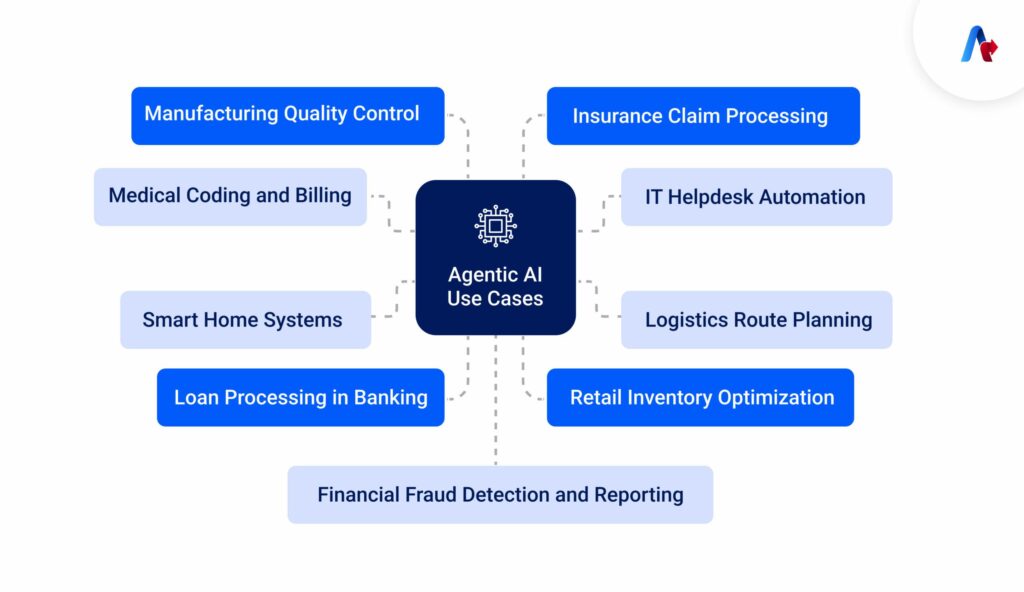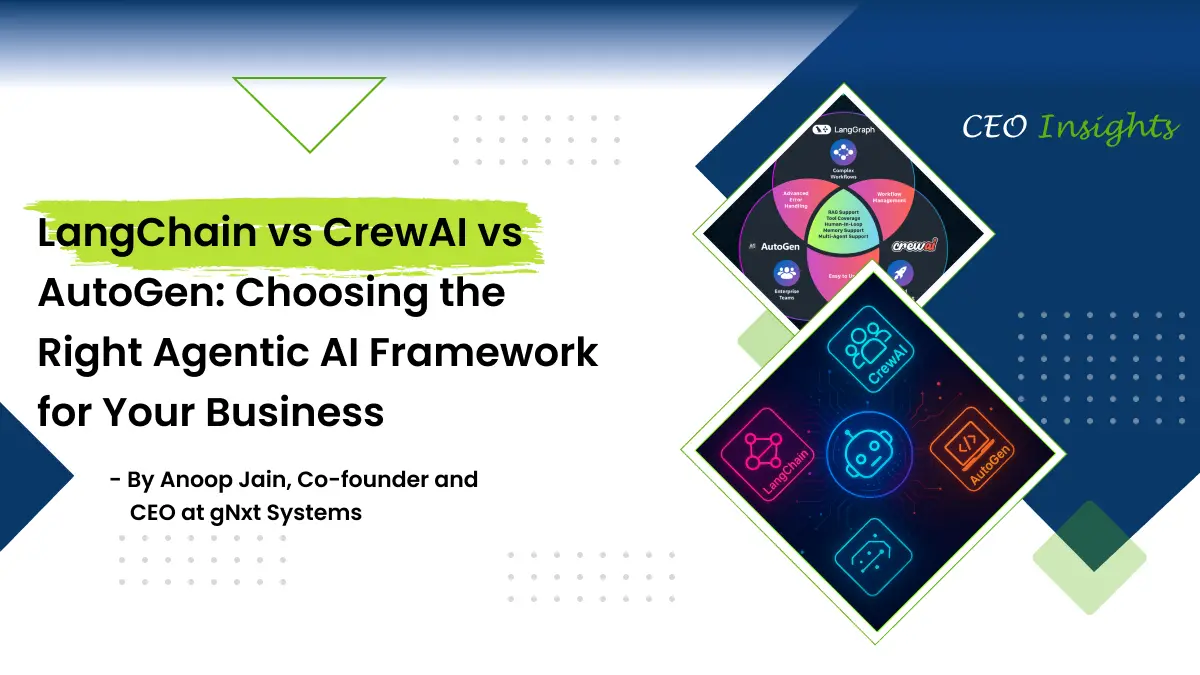- August 22, 2025
- by Anoop Jain
LangChain vs CrewAI vs AutoGen: Choosing the Right Agentic AI Framework for Your Business
The Rise of AI Agent Frameworks in Business
The business landscape in 2025 is defined by Agentic AI—intelligent systems capable of reasoning, memory, collaboration, and autonomous task execution. Frameworks such as LangChain, CrewAI, and AutoGen are shaping the next wave of enterprise transformation, enabling organizations to automate knowledge work, accelerate innovation, and unlock operational efficiency.
Gartner predicts that by 2027, over 40% of enterprise applications will embed agentic AI workflows, driving significant cost savings and productivity gains. Choosing the right framework today will determine how effectively a business leverages AI tomorrow.
A Closer Look at the Big Three

LangChain: Enterprise-Grade Flexibility
LangChain has emerged as the most widely adopted framework for building modular, production-ready AI pipelines. With its extensive integration ecosystem, it enables organizations to connect large language models (LLMs) with databases, APIs, retrieval-augmented generation (RAG), and third-party enterprise tools.
- Key Strengths: Ecosystem maturity, broad tool integration, enterprise-scale deployment.
- Business Use Case: A global financial services firm used LangChain to automate compliance monitoring by chaining multiple LLM agents for data extraction, semantic search, and reporting—reducing manual review efforts by 60%.
CrewAI: Human-Like Collaboration Through Agent Roles
CrewAI introduces a unique approach: structuring AI into “crews” of specialized agents, each assigned a distinct role. This mirrors human team dynamics, making it particularly effective for complex, multi-step workflows.
- Key Strengths: Role-based decomposition, strong memory support (short-term, long-term, entity-level), intuitive design.
- Business Use Case: A leading e-commerce player adopted CrewAI to manage product catalog updates. A “Research Agent” sourced product details, while a “Validation Agent” cross-checked accuracy, and a “Publishing Agent” automated listings. Result: a 75% reduction in catalog update time.
AutoGen: Conversational Multi-Agent Intelligence
AutoGen, originating from Microsoft research, is built around conversational collaboration between agents. Agents can interact with each other using natural language and code, making the framework ideal for dynamic, multi-agent problem-solving.
- Key Strengths: Conversational orchestration, flexible topologies, no-code design studio for rapid prototyping.
Business Use Case: A global consulting firm leveraged AutoGen to develop a client-facing knowledge assistant. Agents collaborated conversationally to fetch, summarize, and present insights from thousands of reports. This enabled consultants to cut research time by 40% while improving client delivery speed.
Comparative Framework Matrix
Feature / Use Case | LangChain | CrewAI | AutoGen |
Architecture | Modular, chain-based workflows | Role-based crews on LangChain foundation | Conversational, multi-agent systems |
Memory & State | Strong with LangGraph & observability tools | Rich (short-term, long-term, entity-level) | Contextual, conversation-driven |
Ease of Use | Advanced; suited for engineering-heavy teams | Intuitive; easier adoption curve | Balanced; accelerated by no-code Studio |
Integration Ecosystem | Largest—databases, APIs, vector stores, RAG | Inherits LangChain integrations | Flexible with conversational coordination |
Best Fit | Enterprise-scale, complex LLM workflows | Rapid prototyping, structured multi-agent collaboration | Agile multi-agent apps, conversational business use cases |
Strategic Guidance: Matching Framework to Business Goals
- LangChain: Best for enterprises requiring scalable, compliance-ready AI with deep integrations across data systems.
- CrewAI: Best for companies seeking human-like agent teamwork, rapid prototyping, and workflows that require structured memory.
- AutoGen: Best for organizations focused on dynamic collaboration, client-facing assistants, and innovation labs needing fast experimentation.
Case Studies Snapshot

- Healthcare: A hospital network built a medical research assistant using LangChain, connecting LLMs to medical databases. It reduced clinical trial research time by 45%.
- Retail: A retail chain adopted CrewAI to coordinate pricing, inventory, and competitor analysis. The role-based system helped them achieve 30% faster market response cycles.
- Consulting: AutoGen was deployed in a Big-4 consulting firm’s knowledge practice to orchestrate multi-agent research, cutting delivery preparation time by days per engagement.
Conclusion: Building the Future with gNxt Systems
The decision between LangChain, CrewAI, and AutoGen is not just about frameworks—it’s about strategic alignment. Each offers distinct advantages: LangChain’s maturity, CrewAI’s collaborative structure, and AutoGen’s conversational dynamism.
At gNxt Systems, we specialize in guiding businesses through this complexity, helping them select, integrate, and scale the right AI agent framework for their unique needs. Whether your goal is operational efficiency, customer engagement, or data-driven decision-making, the right framework is the foundation for future growth.
For enterprises new to AI, CrewAI offers a balanced learning curve with structured collaboration. It is easier to deploy compared to LangChain’s complexity while still offering robust memory and workflow support.
Yes. Many organizations adopt a hybrid approach, using LangChain for infrastructure and data integrations, CrewAI for structured multi-agent collaboration, and AutoGen for conversational workflows.
Not inherently. Costs depend on scale. LangChain often requires heavier engineering investment upfront, but provides higher ROI for enterprises needing long-term, production-grade systems.
AutoGen stands out for customer-facing use cases due to its conversational, multi-agent architecture and no-code Studio that accelerates iterative development.
All three frameworks support integration with enterprise-grade security models. However, LangChain—with its observability tools and structured deployment features—tends to be the preferred choice for compliance-heavy industries such as finance and healthcare.
Read this blog by gNxt Systems. It might interest you: What is HyperAutomation?
About Author

CEO at gNxt Systems
with 25+ years of expertise, Mr. Anoop Jain delivers complex projects, driving innovation through IT strategies and inspiring teams to achieve milestones in a competitive, technology-driven landscape.


